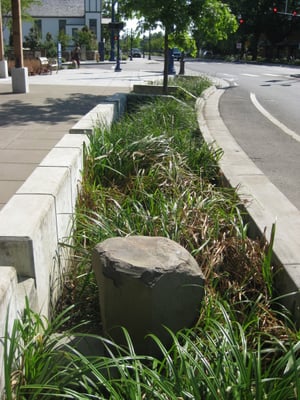 The Washington State Department of Ecology (DOE) is making Low Impact Development (LID) a priority in a major way: they are mandating the use of LID technologies for stormwater design and construction across the board.
The Washington State Department of Ecology (DOE) is making Low Impact Development (LID) a priority in a major way: they are mandating the use of LID technologies for stormwater design and construction across the board.
Every agency in Washington will eventually be affected by this new rule. Will your agency be ready?
This change may be unsettling to some, but I think it is a good thing. I have been an advocate of LIDs for some time because LID stormwater design is typically more aesthetically pleasing, can be integrated into a site or roadway landscape scheme, and stormwater runoff will better mimic the natural flow of water. I’ve worked on a variety of projects that incorporated LID measures, and based on my experience I wrote a blog post last year that debunked some common LID myths. LID may not be right for every situation, but the benefits are substantial where it is the right fit.
LID can mean a lot of different things to people, so before discussing when the standards take effect, I would like to provide a brief LID refresher.
What are LID Practices?
In engineering language, LID best management practices (BMPs) are distributed stormwater management practices, integrated into a project’s design, that emphasize pre-disturbance hydrologic processes of infiltration, filtration, storage, evaporation and transpiration. Put more simply, LID (sometimes referred to as Green Infrastructure) is an attempt to mimic how nature treats and disposes of stormwater runoff.
Typical LID BMPs include, but are not limited to, bioretention/rain gardens, permeable pavements, roof downspout controls, dispersion, soil quality and depth, minimal excavation foundations, vegetated roofs and water reuse. My colleague Lisa Stenberg wrote about a case study from the City of Puyallup that included a variety of these LID BMPs.
For example, imagine a vacant property with moderately-drained soil. A good portion of the water that hits the site is absorbed into the soil and eventually recharges the groundwater. Imagine that property is developed and covered with impervious asphalt and buildings, and all the runoff is directed to a pond near one of the property corners and discharged into a storm sewer system. That is a standard way to deal with stormwater, but it does not mimic natural processes and can have unintended consequences for the water table.
Now imagine that same site being developed while incorporating pervious asphalt, allowing water to filter through to the soil beneath. Essentially the entire parking lot becomes a storm facility and mimics the natural condition. That is what LID is all about.
What is DOE Mandating and When does it take Effect?
DOE’s new rule will impact you and your agency because it requires each jurisdiction in Washington State to fully implement LID site requirements into stormwater ordinances and development codes. For many agencies, that means not only understanding what LID BMPs are, but also understanding how best to codify LID measures. This is no small task.
This new requirement takes effect in phases over the course of the next few years. If you’re in a Phase I city or county, which primarily applies to large cities and counties in Western Washington, you’re probably already aware of the fact that your agency’s deadline for compliance is June 30, 2015. Hopefully your agency is already working on its code updates.
For the rest of the state, the implementation deadlines are as follows:
-
December 31, 2016: Most Phase II Western Washington municipalities
-
June 30, 2017: Cities of Kelso, Longview, and Centralia and Cowlitz County
-
December 31, 2017: Eastern Washington municipalities (LIDs must be provided as an allowable stormwater management technique)
-
June 30, 2018: City of Aberdeen
The Washington State Department of Transportation is temporarily exempt, but I anticipate they will eventually have to comply as well.
Those dates may seem a long way out, but you know how quickly time passes when trying to rewrite code and get the amendments approved by planning commissions, city councils, or county commissioners. Now is the time to begin.
In the coming months, look for posts on our blog about code integration tools, funding programs, and other available resources to assist your agency with implementing LID.
And don’t dismiss this topic just because your agency is in another state. While these regulations are being adopted in Washington, it’s only a matter of time before other states follow suit. Getting ahead of the curve is your best option.
How do you feel about LID measures in general, as well as mandating LID measures in your agency’s code? Please leave a comment below to let me know.


Leave us a comment below